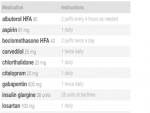I will be taking over the ER coding and would like some clarification from fellow ER coders. It has been instructed to me that I should code secondary conditions that are in the Medical History and the patient is taking a medication for this condition to code it. For example, HTN on Lisinopril. This condition is not addressed anywhere else in the encounter. Would this be coded? or should I only code conditions that are actively addressed.
Thanks for all the help.
Thanks for all the help.
